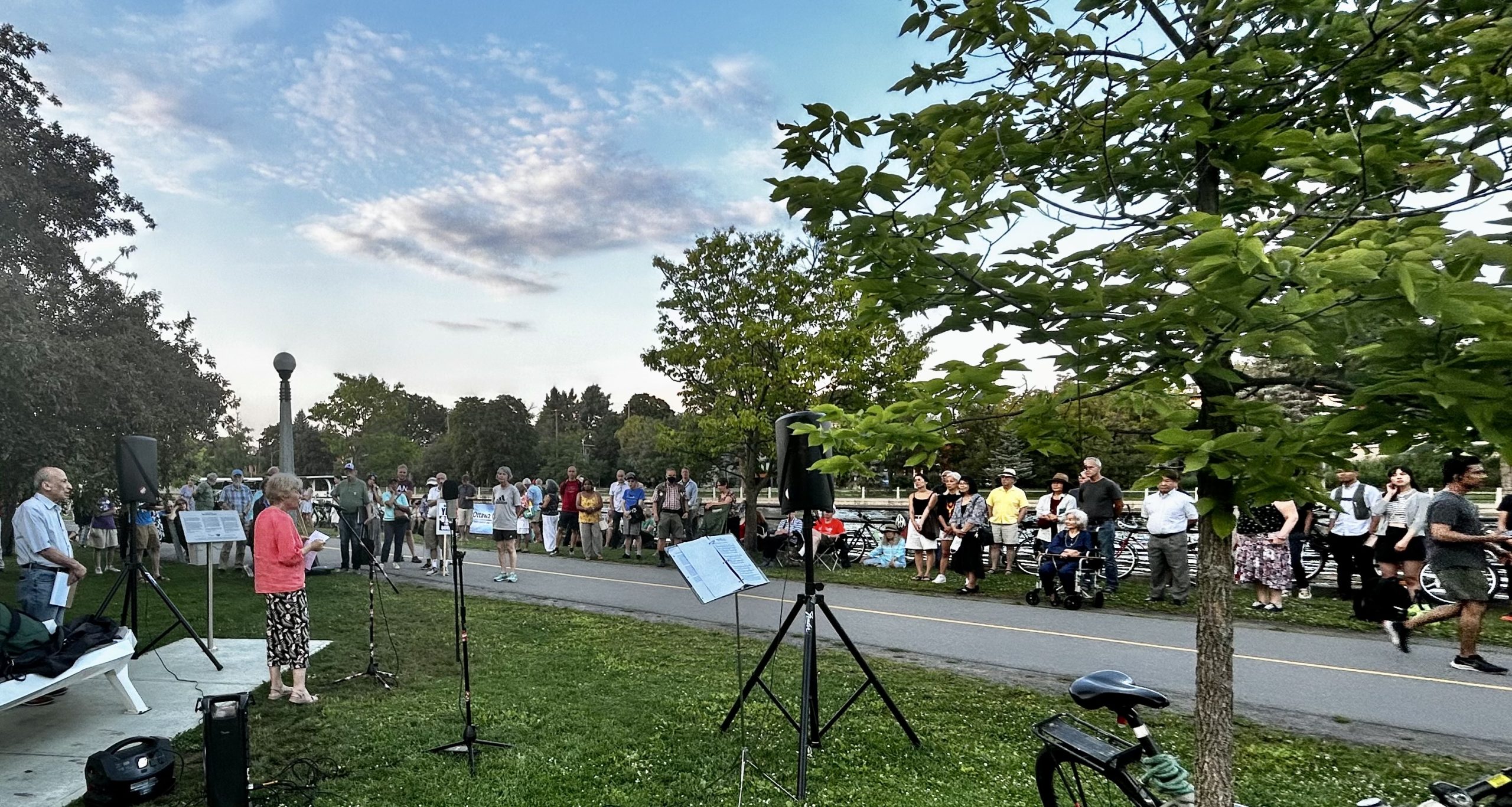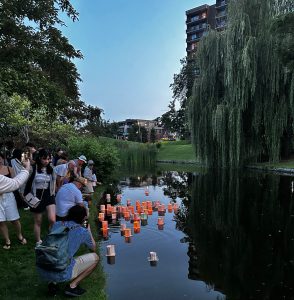 Climate change threatens Canada’s forest carbon sinks: What can we do?
Climate change threatens Canada’s forest carbon sinks: What can we do?
Published in Peace Magazine, Summer 2023 Issue
David Price and Robin Collins
We penned an opinion piece titled A counterintuitive climate defence: Harvesting forests to combat emissions (Globe and Mail, 5 June 2023) which has raised significant controversy. Briefly, Canada’s forests can help mitigate anthropogenic CO2 emissions, but public perception of this role is confused. Climate change is pervasive and will affect all of Canada’s forests, which threatens their role as a “carbon sink”; it also intersects with a common desire to protect remaining old-growth forests from logging, even though some old-growth ecosystems, and the carbon they store, are vulnerable to a warmer and drier climate. We advocate for a nation-wide project to “triage” the vulnerability of all forests. We cannot say where the lines will be drawn, but three major classes would be identified.
“Protectable forests” will be able to withstand effects of climate change for a significant period without human intervention. “Disappearing forests” are unlikely to survive past 2100 in spite of any justifiable effort to save them. Separating these two classes are “Manageable forests”, where the cumulative effects of drought, wildfire and insect herbivores will cause significant deterioration in ecosystem health, threatening their long-term survival and biodiversity. Responsible management can foster forest adaptation to changing conditions and recover ecosystem health. In particular, efforts to preserve old-growth forests from logging should be targeted at those in the Protectable class, while Manageable forests should become the primary source of raw materials. Further, Canada’s forestry industry could be expected to replant areas affected by natural disturbances as well as logged areas, and aim to make silvicultural practices as sustainable as possible. Most importantly the industry would improve utilization of harvested wood, and wherever feasible, expand production of construction materials that keep carbon out of the atmosphere for longer than generally occurs in natural forests. Here we respond to some of the questions and arguments our article has provoked.
- Why might it take 1,000,000 years for atmospheric CO2 to return to pre-industrial levels if we allowed it to happen naturally, and why would accelerating this process be “stupendously challenging and costly”?
Ice-core data from Antarctica and Greenland show CO2 concentration varied around 250–300 ppm, during several cycles of glaciation and deglaciation beginning around 900,000 years ago. Geological research tells us today’s concentration over 420 ppm last occurred over 2 million years ago. Therefore, it took over a million years for the natural world to bring CO2 down to pre-industrial levels. Within the last few centuries, humans have seriously degraded natural C sinks and biodiversity, so we cannot expect today’s biosphere to work more rapidly.
Technological solutions for direct CO2 removal will also be essential, but will require “stupendous” amounts of air to be pumped continuously over CO2-absorbing surfaces to remove only 0.04% CO2. It will take a century or longer to get down to 350 ppm—and every year of delay makes the task even bigger. The energy required for that effort will also be stupendous.
- Why are small trees and younger forests stronger carbon sinks than bigger trees and older forests? How can you also say that old-growth forests able to live another 100 years will retain much of their carbon?
Young forest stands composed of small trees that have reached maximum leaf area can grow rapidly, as they lose relatively small amounts of CO2 from respiring tissues (though residual dead materials may release CO2 through decomposition for many years). Older stands of big trees have similar leaf area for photosynthesis (averaged over the same ground area!), but have much more respiring tissue, so CO2 absorption decreases progressively as the stand ages. Dead material also accumulates in an older stand, feeding a host of decomposing organisms, all of which further reduce CO2 uptake by the forest.
If big trees in old-growth forests can live for a long time, surviving effects of climatic change, most of the carbon they contain will be preserved. Logging such forests often results in significant wasted wood, which decomposes over decades (not immediately). This releases more CO2 in the early years of the replacement stand, requiring more time for it to become a net C sink.
- Where is the evidence that half the carbon in houses built today will remain intact for 100 years?
Several studies carried out recently in Canada and in the USA have examined how harvested wood products act as carbon stores. Notable examples are Heath et al. in the USA, and Dymond et al. in Canada. Long-lived wood products (LLWP) used in timber-framed buildings, including sawn lumber and a range of engineered materials like plywood and oriented strand lumber, are protected from fire and decay. From public records, and studies of house demolitions (where all wood components are weighed), we can estimate how much wood was used to build houses in the early 20th century and how many buildings remained in use several decades later. The loss of carbon stored in housing (due to demolitions, renovations or house-fires), can be estimated from these data, and follows an exponential decay curve. In general, close to half the wood used in single family houses persists for about 100 years (with smaller fractions for multi-unit residential and commercial buildings).
Taking this ~50% loss into account, we estimated the LLWP obtained from logged areas between 2011 and 2020 will keep about 100 Mt C out of the atmosphere for a century. Wood recovered from demolished buildings might be processed into biochar for use in agriculture and horticulture, instead of land-filling, extending the persistence of carbon in LLWP.
- In these days of more frequent wildfires that “create their own weather”, all woodlands seem to be vulnerable. Shouldn’t the primary task be to modify how we control fires?
Wildfire is a natural occurrence in most Canadian forests. Following European colonization, fire-suppression became a major concern, and as methods became more effective in the mid-20th century, the average age of managed forests increased, along with fuel accumulations. But a warming climate drives hotter and drier periods which, with extra fuel, make fires more intense and increasingly difficult to suppress—leading to larger areas burned on average. (One unavoidable consequence will be increasing areas of young stands and less old forest.)
Identifying forests which require intervention to survive climate change would allow better integration of fire management practices (e.g., controlled burning) into a carefully planned cycle of regeneration, tending and harvesting on smaller patches of land. (We can also learn from traditional Indigenous burning practices.) A more fragmented landscape (possibly containing more deciduous species in place of conifers) will help contain future wildfires. Fires will spread less rapidly across open areas cleared of fuel, and a well-planned network of roads and clearings allows faster and safer access and exit for fire-fighting crews and equipment.
- How do you know Alberta gets such low annual rainfall and why should we believe models that suggest Alberta’s boreal forests will disappear by 2100?
Over the last 30 years, advances in computing and geospatial software have enabled millions of weather station records to be compiled into huge databases and analysed, allowing much better mapping of climate variables. For Alberta, spatially and temporally averaged precipitation is the lowest of all ten Canadian Provinces (though NWT and Nunavut receive lower amounts).
Many ecological models have been developed, generally by field ecologists working closely with computer modellers. The work we cite is one of at least three studies which project loss of conifer-dominated vegetation from “upland” forested sites in central and northern Alberta by 2100. (Upland sites are typically drier than the intervening boreal wetland sites where other changes could occur.) As drought and fires could kill off much of the upland pine and white spruce, they would likely be replaced by deciduous species (mainly aspen) for several decades.




 Climate change threatens Canada’s forest carbon sinks: What can we do?
Climate change threatens Canada’s forest carbon sinks: What can we do?